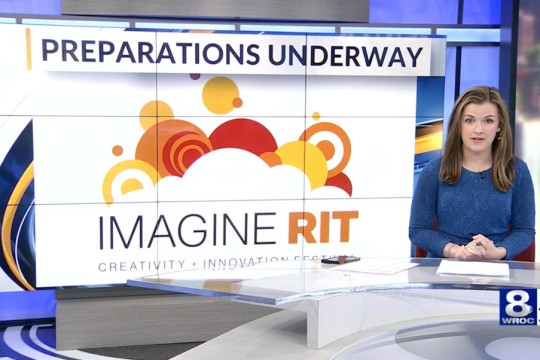Press finds new home in Lawson Publishing Center (May 10)
Rendering of typography inscribed on an outer glass wall featured in the Alexander S. Lawson Publishing Center.
RIT’s Cary Graphic Arts Press will move into its new home next month. The ceremonial unveiling of the Alexander S. Lawson Publishing Center will be held from 4 to 5:30 p.m., Thursday, May 10. The newly renovated space on the second floor of Wallace Library will feature an exhibition gallery, a sales area for press titles, office space and expanded production offices. “The Lawson Publishing Center will provide a visible presence for the RIT Cary Graphic Arts Press,” says David Pankow, curator of the Cary Graphic Arts Press and director of the Press. “We anticipate a lot of visitors to the public spaces in the new facility and we look forward to meeting with potential authors who have manuscripts they want to submit for consideration. The press follows customary university press standards and every manuscript is peer reviewed and then, after being accepted for publication, each new title is produced to the highest possible design and production standards.”
The new facility is named in honor of RIT’s first Cary Professor and an early proponent of an RIT university press. The Lawson Publishing Center is the first major step in establishing a university-wide press presence at RIT. The Cary Graphic Arts Press has been spearheading publishing projects with increasing regularity since its first commercial release, Digital Book and Publishing, in 2001. It has published 40 books to date under its original imprint, but that will soon be changing with the addition of a new, streamlined second imprint.
The first publication with the RIT Press imprint will be a revised and enlarged edition of the history of RIT, written by Dane Gordon, professor emeritus of philosophy. The full title of the new book is Rochester Institute of Technology: Industrial Development and Educational Innovation in an American City, 1829-2006. “We expect to use this imprint in the future on all titles that are non-graphic arts related,” says Pankow. “This additional imprint allows us to legitimately describe ourselves as RIT’s University Press without reservation. We are very excited we have reached the point where we can broadly advertise our presence to the academic community.” Gordon will officially launch his book at the center’s opening.
Hermann Zapf, a typeface designer and Lawson’s successor, will also take part in the May 10 ceremony. Zapf taught in RIT’s School of Printing from 1977 to 1987. Throughout his career, Zapf designed numerous typefaces including Palatino, Optima and Zapfino. Zapf, along with award winning calligrapher and graphic designer Jerry Kelly, prepared the typography for the center’s glass wall. The motif of the Golden Mean, in a version adapted for book page-layout design, is the inspiration for the overall design of the center. A glass wall inscribed with famous quotations about reading, publishing and typography, follows a spiral curve and sits on a wood floor bearing the rest of the design inlaid in its surface.
Valerie O’Hara, an RIT alumna and owner of Pike Stained Glass Studios, is handling the glass fabrication. A selection of paintings, “Graphic Communications Through the Ages,” donated to RIT in 1974 by Kimberly-Clark Corp., will be the first exhibit in the center’s gallery space. The paintings focus on great moments in bookmaking. The first book published under the new RIT Press imprint is an expanded history of RIT by Dane Gordon, professor emeritus.
Gordon spent 10 years researching and writing the first edition of Rochester Institute of Technology: Industrial Development and Educational Innovation in an American City, published in 1982. That project covered RIT’s first 150 years. In 2000, with RIT’s 175th anniversary approaching in 2004, President Albert Simone asked Gordon to consider updating the history.
The new book takes the RIT story into 2006 and the announcement of Simone’s retirement. Gordon conducted hundreds of interviews and spent countless hours reviewing institute committee reports, letters, publications, journals and news accounts. Among the important events covered in the expanded book are the 1991 CIA controversy and the growth of RIT. At 712 pages, the new book is substantially larger than its 428-page predecessor. Also new is a section of color photography. The book will soon be available in hard-cover and paperback editions. A special preview edition will be on hand for inspection by guests and visitors.















